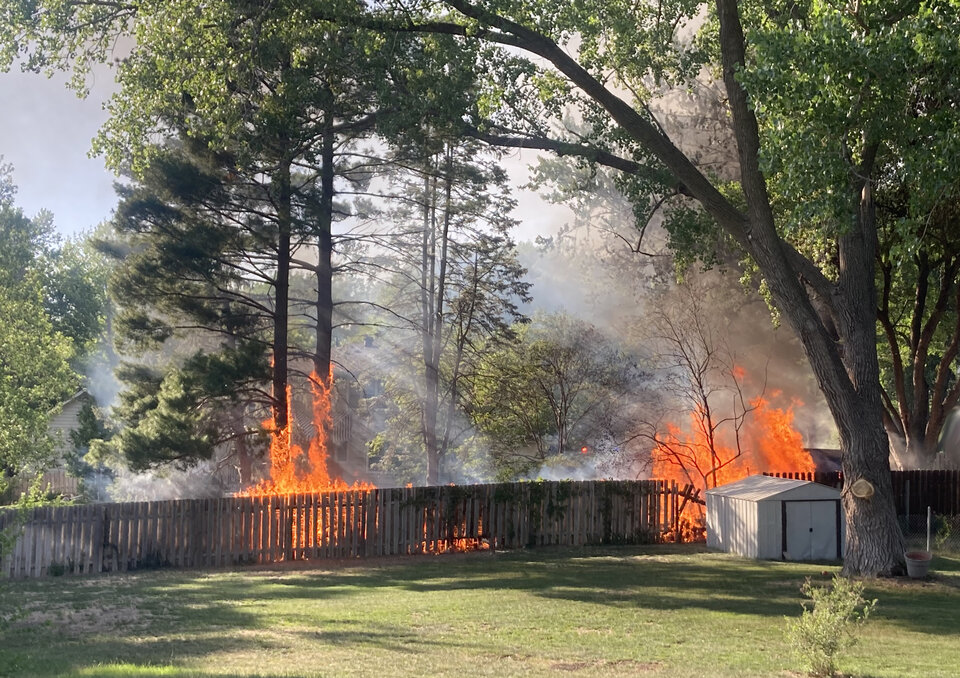May is Wildfire Prevention Month: Fire Smart Landscaping

Wildfires have been headline news not only in Nebraska but across the country. It’s comfortable to think a devastating wildfire can’t happen in your area, but it’s better to be aware of the possibility and be prepared. Learn the aspects of Fire Smart Landscaping including creating a defensible space, planning ahead for a fire event, and management of the surrounding landscapes to decrease potential fire damage.
Creating a Defensible Space Three factors determine wildfire behavior: fuels, weather, and topography. Fuel is the only one that humans can impact. Utilizing a defensible space can help to decrease the fuel load and potential for fire spread.
There are three zones to a defensible space.

Zone 0: The Ember Resistant Zone: 0-5 feet from the house. The objective of this zone is to create the most fire-resistant zone in the area immediately surrounding the home or structure to avoid ignition from blowing embers. The greatest hazard for this zone is plants against the house and near doors and windows. The recommendation for plants used in this zone are low growing, non-woody, herbaceous plants that are 18” tall or less. The plants should be planted sparsely with plenty of space between plantings. If mulches or walkways are used in this zone, only non-combustible materials are recommended, like concrete, brick pavers or gravel. Some of the aspects to avoid in this zone include climbing plants, branches within 10’ of chimney, litter in roof gutters, combustible items under the deck, combustible containers, mulch, fencing, furniture, firewood, combustible landscape items attached to the house like fences, arbors, trellises.
Zone 1: The Lean, Clean, and Green Zone: 5-30 feet from the house. The objective of this zone is to reduce the heat and movement of flame by creating a ‘lean and clean’ environment. Plants used in this zone should be low growing and well irrigated. Also allow for ample spacing between plants. Non-combustible materials should still be utilized for walkways. Organic mulches can be used in this zone if they are broken up and not a continuous mulch bed. Firewood, lumber, and other flammable items should be moved out of zone 1. Management of plant material is critical in this zone. Dead plant material and overgrown plants should be removed routinely.
Zone 2: The Reduce Fuel Zone: 30-100 feet from the house to the property line. The objective of this zone is to decrease the energy and speed of the fire by eliminating continuous, dense vegetation both vertically and horizontally. This zone is often a transition zone between managed and outer fringe areas of the landscape. In this zone, plants may not need to be irrigated once established. Wood mulch can be used in larger expanses in this zone. Depending on the location, collaborating with neighbors would be a good idea. Woodpiles and lumber, gasoline generators, and propane tanks should be kept at least 30’ away from any structure and 10’ from plants.
Fire Smart Guidelines for Spacing Plants:
Provide vertical and horizontal space between shrubs and trees. Leave space between plant groupings. Avoid planting in rows or hedges (unless the planting is a windbreak)
Vertical Spacing: Large trees don’t need to be cut and removed as long as all of the plants beneath them are removed. This eliminates a vertical ‘fire ladder.’ Avoid mass planting shrubs at the base of trees. Remove limbs 6-10’ from the ground or make sure that there is 1/3 trunk to 2/3 canopy. Windbreak trees are not recommended to be pruned up off the ground for clearance.
Horizontal Spacing: Create horizontal and vertical spacing between plants, the amount of spacing will depend on how steep the slope is and the size of the plant. For flat to gently sloping (0-20% slope) the recommended defensible space distance for shrubs and trees is 100 feet apart. As the slope gets steeper (21-40% slope) then the distance between the planting needs to be increased to 200 feet for shrubs. A very steep slope (+40%) trees and shrubs need to have a 200-foot distance between plant material.
Fire Smart Plant Selection: All plants burn, but some have traits that make them more flammable than others. High oil or resin content, low moisture content, tall growth, open growth form, fine twiggy stems and high-water needs all contribute to an increase in the plant’s flammability. Plants with low oil or resin content, high moisture content, compact growth form, green stems, drought tolerant, or plants that contain soap, latex or pectin have lower flammability. Select plant material that is the right plant for the right place and that matches the landscape aesthetic. It is more important to consider where a plant is placed and how it is managed.
Management of a Fire Smart Landscape: The objective of managing a fire smart landscape is to reduce the amount of fuel. Before each fire season, the property needs to be reevaluated. Dead or dried plants, branches, and leaves need to be removed. Combustible plant debris on and under decks needs to be removed. Equipment needs to be used properly to avoid sparks, especially when conditions are dry. Routinely remove and dispose of overgrown plant material from the landscape.
Creating and maintaining a defensible space, following fire smart guidelines for plant spacing and selection and properly managing the landscape can all help to decrease the potential for a fire to spread through the landscape.
References:
Living with Fire A Homeowners Guide- Nebraska Forest Service https://nfs.unl.edu/documents/fireprotection/Living%20with%20Fire%20Eastern%20NE%208x11%20low.pdf
Protecting Your Home from Wildfire- Colorado State Forest Service
https://static.colostate.edu/client-files/csfs/pdfs/FIRE2012_1_DspaceQuickGuide.pdf
University of California- UC Marin Master Gardeners Fire Smart Landscaping curriculum
https://marinmg.ucanr.edu/BASICS/FIRESMARTLANDSCAPING/
Ready for Wildfire.org-https://www.readyforwildfire.org/prepare-for-wildfire/get-ready/fire-smart-landscaping/
Idaho Firewise checklist: https://idahofirewise.org/wp- content/uploads/2017/04/idXevalXhomeownerXversion.pdf
This article was reviewed by Nicole Stoner